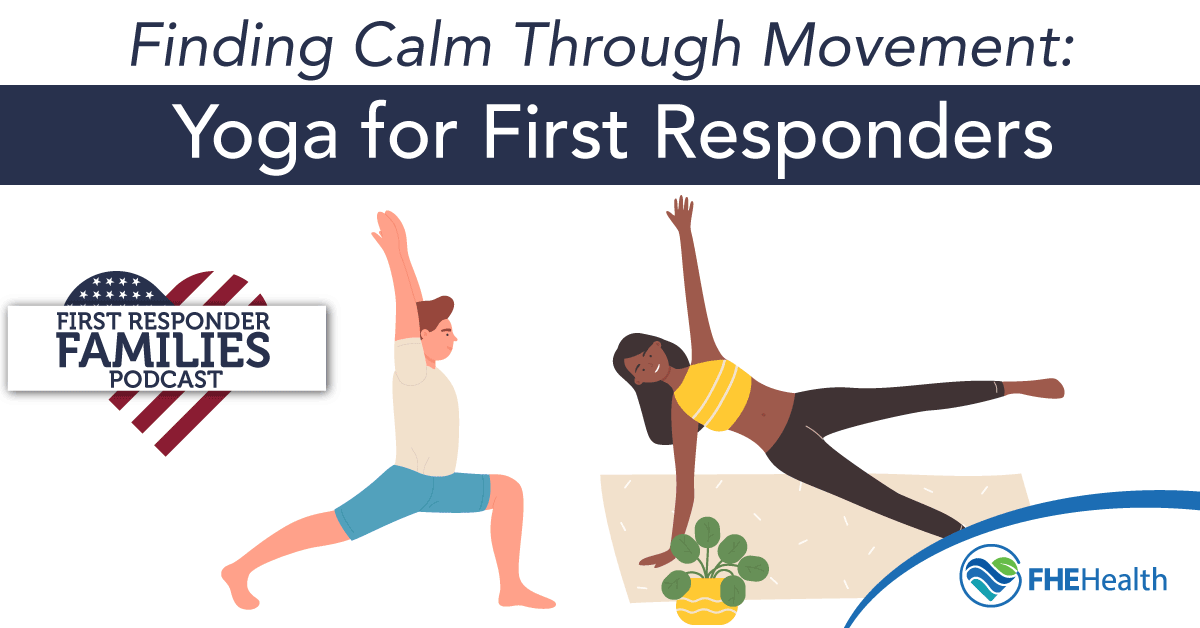
Long before she founded Yoga for First Responders, Olivia Mead was a student in New York City. Every day on the way to school she passed the Midtown fire station, where she’d exchange high fives with the firefighters there. Many of those same firefighters would die in the rubble of the Twin Towers.
Yoga … for First Responders? The Beginning
In a March 2025 podcast interview with FHE Health’s Director of Family Services Ivona Bhadha, Mead shared how “that seed,” in the form of those early interactions, developed into a passion for teaching yoga to first responders and giving them tools for coping with traumatic stress.
More than a decade after 9/11, Mead was living in Los Angeles, teaching yoga in gyms and studios in the Beverly Hills area. She was also feeling increasingly disenchanted with a culture of “commercialized yoga” and eager to “teach [yoga’s] true lessons.”
Mead wanted “to teach someone else,” she told Bhadha in their interview. “And I wanted to focus on veterans and the military because at that time, the awareness of suicide and post-traumatic stress in that population was increasing.”
Training in Occupational Trauma and Outreach to First Responders
This newfound desire to work with first responders inspired Mead to pursue training in the area and to reach out to the L.A. Fire Department, asking “what about yoga?” The answer that came back was, “We’ve kind of wanted to do this, but we don’t know how we’re going to introduce this. What do you call it?”
What insights did Mead gain after that about first responder mental health needs? Or about how yoga can benefit first responders in particular? Get her answers to these and some of the other questions from the podcast below.
Some Q & As from the Podcast
How do you get first responders interested in yoga?
Mead: So … the science and the research, right? So … if I’m telling you, “Look at all these studies that show this dramatic decrease in post-traumatic stress when you do … just yoga in general” — and our program does even more, and it’s specifically for first responders — so if I show that to someone and then they still say ‘no’ … it’s their choice. But what we’re supplying is hard data and research that shows we have an answer to this problem [of post-traumatic stress].
What is the true origin of yoga and what are the misconceptions?
Mead: Yeah, absolutely. So, the authentic intention, the original intention, why this yoga training came to be, was to master the mind, to have a training to master your mind and optimize the functioning of your entire system, your mind, body, and nervous system … And then the original population that used [yoga] was the warrior class, because they needed to have … an edge, and that edge is a mental and neurological edge … at the end of the day, yoga is a mental and neurological training system, and we use the physical part to get into the mind and body.
How would you define what the “flow state” is?
Mead: We love to talk about it. It’s so cool. And some people may recognize it as … “in the zone.” And all of us have experienced this because it’s not always when you’re doing high performance. You could be talking to someone you love and three hours later … you didn’t even realize three hours went by, right? It’s the ultimate state of mindfulness … Flow is not just a feeling. Being in flow in the zone is … something that happens in the brain … You are performing at your highest level, and it feels good, and it feels easy.
So, folks started to research flow state, how people get in it, what is required for it….
A Guide to Reaching Your Flow State – 4 Requirements
Mead went on to share what four things, based on research findings, are essential to reaching a flow state. What are those four things? Find out by tuning in to the podcast here.
The First Responder Families Podcast is a free resource made possible by national behavioral health provider FHE Health. Host Ivona Bhadha draws from her own clinical expertise in family therapy to interview guests about a variety of topics that affect first responders and their loved ones and to equip them with tools for their mental health journey.






